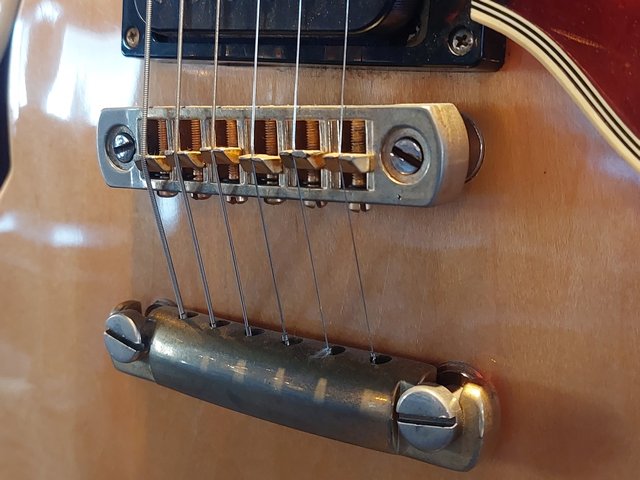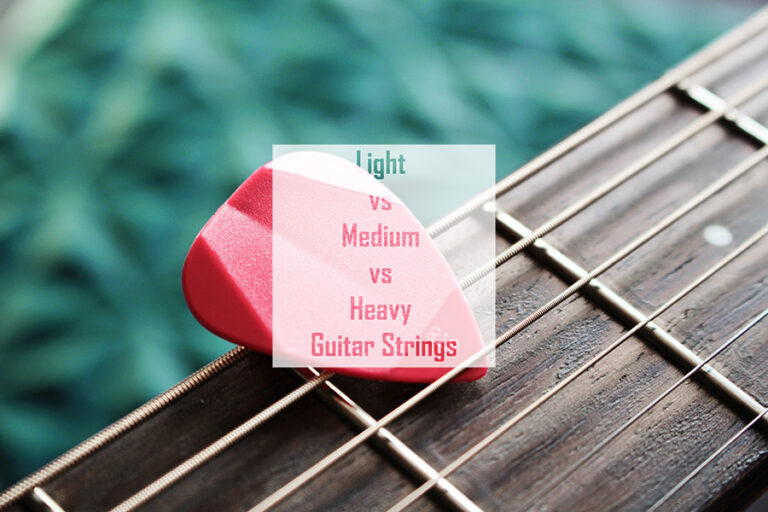Among the things most overlooked when buying a new guitar is the thickness of the strings. While most guitars come with medium gauge strings, some specific ones may come with light or even heavy strings.
The thickness, usually referred to as the gauge of the strings, affects the tone, volume (mainly in the case of acoustic guitars), and most importantly, the “feel” of the strings when strumming or fretting. The choice of string gauge is largely subjective and something that would require trial and error until you find a set of strings that suits you and your playing style the best.
As you develop your techniques and your playing style and expertise evolve, your string gauge may change over time to complement and facilitate your style. While some people do not give much thought to strings early on, I consider it a quest in the right direction if you’re here as a beginner. For example, a heavy gauge string on your new guitar may make the process of learning and initially producing a good, crisp sound more difficult than it should be in case you used lighter gauge strings.
If string gauge makes learning guitar easier, why not use lighter strings? While a lighter gauge string may be a better choice for many beginners, the answer is not as straightforward. Let me give you a brief overview of how different string gauges have distinct properties. And that there is no “best” string, only the string that is better suited for you, which you’ll hopefully be able to decide on after reading this article.
Light strings are easier to fret and strum and provide good resonance with lighter strums but produce less volume (in the case of acoustic guitars), a thinner tone and are more prone to break. They are also challenging to tune down since they become wobbly under the less tension of the down-tunings.
Heavy strings, on the other hand, may be harder to fret as they are under more tension unless you have developed calluses on your fingertip and have enough finger strength. They can produce much more volume, resonance, and a thicker, fuller tone. These strings can be tuned down easily and strummed without fret buzzing as long as the action is set right. Medium strings are between these two; therefore, most typical guitars come with medium strings. If in doubt, go with medium strings.
How Does Guitar String Gauge Matter?
We have learned how string gauges affect how you play and hear the sound of your guitar, let’s now see the difference between light, medium and heavy strings in detail and how they affect everything from the tone to the playability. Also, not all strings, especially the extra-light or extra-heavy strings, may be compatible with your guitar.
While the extra light ones might turn out wobbly and unplayable, the extra-heavy strings may even damage or worse — snap the neck of your guitar. However, note that the difference in sound and tone may be very subtle at times between strings only a few gauges apart. Sometimes they might even sound the same. However, the playability will be different in terms of how they feel.
Playability
String gauges would generally most affect the playability. A beginner who has been playing medium or heavy gauge strings for the entirety of their beginning months would be amazed to find how good the lighter gauge strings feel for the first time.
Lighter strings are easier to fret and strum — which is vital for beginners. Also, other more advanced techniques like bending and vibrato are more manageable and usually sound better for beginners.
On the other hand, some specific guitars may not sound very well with light strings and would cause buzzing and rattling as the strings start to touch the frets. This buzzing is because of the lesser tension in the strings, making them wobbly and, in extreme cases, even unplayable. Such guitars (usually having longer scales) would require thicker strings like medium-gauge strings. Another benefit of using higher gauge strings is that they give you more freedom to play aggressively. Lighter strings, in some cases, can break mid-performance.
Thicker strings, like anything past heavy, are generally only suitable when you have a specific reason for the choice. Heavy strings will make fretting harder, and you’ll need more finger strength to produce crisp notes. Thicker strings are usually preferred by acoustic guitarists and some electric guitar players who need more of the low-end sound. For most people, however, medium strings will be good enough for a wide variety of music. However, don’t take my word for it — if you are considering getting thicker strings, put them on and see how you like them! They are cheap and accessible and something you should keep a few sets of.
Compatibility
Compatibility is particularly applicable for acoustic guitars as their construction differs from that of an electric guitar. Acoustic guitars need a thin enough soundboard or the top to vibrate with the string to produce the sound (along with the sound chamber). Acoustic guitars are braced to handle the strings’ tension, which is usually substantially higher than electric guitars with thinner strings. However, they are generally made to withstand tension in a certain range. Anything higher, in the case of heavy-gauge strings, may damage the bracing or break the guitar.
For electric guitars, heavier gauge strings in standard tuning pose the risk of the bridge coming off the guitar.
Another issue that you might face with higher gauge strings, irrespective of whether your guitar is an acoustic or electric, is the difference in slot size in the nut. The slots in the nut are usually made for strings as thick as mediums. Anything thicker may make them not fit right and slide off during playing. The only solution to fix this is to have the slots scraped, which can ruin a perfectly good nut unless done with utmost care.
Also, the scale length, which is usually decided by how long your guitar’s neck is, would play a role in whether certain gauge strings would have optimal playability or not. You can get away with lighter (even very light) strings for shorter-scale guitars without a problem. However, putting them on longer-scale length guitars will result in the strings being wobbly, with a lot of buzzing sound, and generally unplayable. It is because of the increased length between the nut and the bridge, and that lighter strings are under very low tension in standard tuning.
Volume
When using thicker strings, the volume will be more affected in acoustic guitars than in electric guitars. Thicker strings require more finger strength to be strummed, converting more of their vibrational energy into audible sound. It is why a typical acoustic guitar would have a gauge of 0.012 (learn more about gauges in the next section), while most electric guitars come with 0.009 or 0.010 gauge strings.
When using very light strings, the volume will be affected even in electric guitars, but you always have the option to turn it up from the amp, whereas, in the case of acoustic guitars, I don’t see a reason to go lower than 0.010. But, again, that’s not set in stone, either.
Tone
Light strings usually have a bright, tinny, and treble-rich tone but lack the fullness of medium and heavy strings. Heavy strings have a mellow, warm, and bass-rich tone with great fullness, deep resonance, and sustain. As you can guess, medium strings are somewhere in between these two. Some people, especially those using acoustic guitars, like the fuller sound of heavy or medium strings and generally don’t like the tone of lighter strings. However, this is largely subjective, and the guitar itself plays a role in the tonal output. Since strings are relatively inexpensive, I recommend you try a few sets of different gauges to see which one you like better.
Frequency Distribution
Frequency distribution is closely related to the tone as how a set of strings favors the low-, mid-, and high-end decides the overall tone. Light strings favor the high end more with a relatively neutral mid and do not have much low end, which is why they lack bass and do not sound full. Medium strings are fuller in comparison as they have more or less an even distribution of low, mid, and high frequencies, while heavy strings favor the mids and lows more, giving a punchier, tighter sound.
String Gauge Chart
The gauge of the string is the diameter of the string in thousandths of an inch, for example a set of Medium (11–49) has strings from 0.011 (high E) to 0.049 (low E). Another more common way to refer to strings is to use the string gauge in inches. So, when we say a set of 0.012 strings, it refers to the thinnest (or the high E) string in the set and that it is 0.012-inches or 12/1000 of an inch.
String gauge and its succession among the strings in a set differs between brands but the following are some examples of common gauges.
Common Electric Guitar String Gauges
| String Name | Gauge |
|---|---|
| Extra Super Light | 8–38 |
| Super Light | 9–46 |
| Regular Light | 10–46 |
| Medium | 11–49 |
| Heavy | 12–54 |
| Extra Heavy | 13–56 |
Common Acoustic Guitar String Gauges
| String Name | Gauge |
|---|---|
| Extra Light | 10–47 |
| Custom Light | 11–52 |
| Light | 12–54 |
| Light/Medium | (12.5–55) |
| Medium | 13–56 |
| Heavy | 14–59 |
Proper Guitar Setup After String Change
Changing the strings of a guitar to a different gauge will often require a proper setup to get the best sound and playability out of it. It means adjusting the action of the strings and, in some cases, especially if you go up or down a lot in terms of gauge, adjustment of the slot width of the nut.
Adjusting the Action

An optimal action is usually the lowest you can have without any buzzing sound. Since different string gauges require a different amount of tension to be in tune and lighter strings, require lesser tension, changing to lighter strings would mean lesser tension and more chance of fret buzzing unless the action is raised. On the other hand, heavier gauge strings have a lot of tension and can have lower action without causing any buzzing.
There are several ways to adjust the action in electric guitar. You can adjust the bridge (in case it is adjustable) or use the truss rod. You can also do a combination of both, but for minor adjustments, one would suffice.
For acoustic guitars, you can use the truss rod to adjust the action as most have a hardtail (fixed) bridge. Sometimes, you may need to sand the bridge or replace it to adjust the action, particularly if your guitar doesn’t have a truss rod.
Adjusting the Nut Slot Width

Many typical guitars will have a nut slot width optimal for medium strings (or any strings that come with it). Going too far away from this gauge will cause issues. This slot width would be wider for lighter strings. It may cause intonation issues as strings may slide in the slot rather than stay firmly in place. On the other hand, heavier gauge strings would not fit the slots and may come off while playing. To address this, you’ll have to carefully sand the slots or take the guitar to a repair shop and expect to shell out some money. You can also replace the nut with something specifically made for your desired gauge. This replacement would also require visiting a guitar repair shop or a luthier.
Choosing Between Light, Medium and Heavy Strings
Light Gauge Strings
Mostly recommended for beginners. However, many experienced players use them as well. Famous for its ease of playing and bright, treble-y tone.
PROs
- Easier playability Brighter treble-y sound
- Better when using tremolo/vibrato
- Better for certain techniques like string bending
CONs
- Cannot play aggressively as there is a risk of breakage
- Lacks volume
- Lacks the lower end frequencies
Go for these if you:
- Play medium strings and feel uncomfortable fretting notes and struggle with getting a clear tone (I can get some flak for saying this :))
- Do or intend to do techniques like vibrato, string bending etc.
Medium Gauge Strings
This is what a typical guitar would come with, has a great balance of playability and good tone. If in doubt you can go with medium or slightly lighter strings like Regular Light (0.010) strings.
PROs
- Good playability
- Balanced tone
- Ample volume
CONs
- None except that the tone is very balanced in some cases, too flat to favor a style demanding either punchier lows or the brighter highs
Go for these if you:
- Are using lighter gauge strings and feel wobblier and finger picking doesn’t feel right
- Are using heavy gauge strings and it is hard for you to fret notes or you’re unable to get crisp and clear tones
Heavy Gauge Strings
These strings are often used by guitarists who want a deeper bass-rich tones especially acoustic guitar players. It is not recommended to go from light to heavy without getting used to medium gauge strings first.
PROs
- Deeper, fuller, richer tone
- Excellent volume
CONs
- Lack of brightness, could be too mellow for some people’s liking
- Hard to play for beginners
Go for these if you:
- Have some experience with medium gauge strings and you feel comfortable playing them
- Want deeper, mellower and higher volume sound
Picture credits
- Guitar Nut Filing by StewMac


